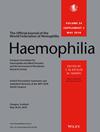Nationwide Study on Factor V Deficiency in China: Clinical Characteristics, Genotype, and Treatment Approaches
Abstract
Introduction
Congenital factor V (FV) deficiency is a rare bleeding disorder caused by recessive variants in the F5 gene.
Aim
To investigate the phenotype and genotype of patients with congenital FV deficiency throughout China.
Methods
Based on data from the Chinese National Haemophilia Registry, we analysed the clinical and genetic characteristics of 45 congenital FV deficiency patients.
Results
The study cohort comprised 45 patients with confirmed FV:C reductions (undetectable to 48%), including six mild (FV:C >10%), 31 moderate (FV:C 1%–10%), and eight severe (FV:C <1%) patients. Of 39 patients with medical history, nine were asymptomatic. Major bleeding (Grade III) occurred in six patients with FV:C <10%. The most common symptoms included gingival (n = 15, 38.5%) and cutaneous bleeding (n = 13, 33.3%) in 39 patients. Menorrhagia (n = 7) was observed in 38.9% of 18 female patients of reproductive age. Gene sequencing identified 33 distinct variants in 20 patients, including 12 novel pathogenic/likely pathogenic variants and one novel variant of uncertain significance. Variants affecting the light chain (vs. heavy chain) were associated with lower FV:C (p = 0.002). Fresh frozen plasma served as the primary on-demand therapy, administered to 19 patients for active bleeding management and to two asymptomatic patients as preoperative prophylaxis.
Conclusion
This study characterizes China's largest FV-deficient cohort, identifying 13 novel F5 variants. Light chain variants predicted severe coagulation disorder, while on-demand FFP achieved effective haemostasis. High prevalences of menorrhagia (38.9%) and ovarian cysts (22.2%) in reproductive-age females highlight urgent needs for gender-specific interventions and management of this rare disorder.

 求助内容:
求助内容: 应助结果提醒方式:
应助结果提醒方式:


